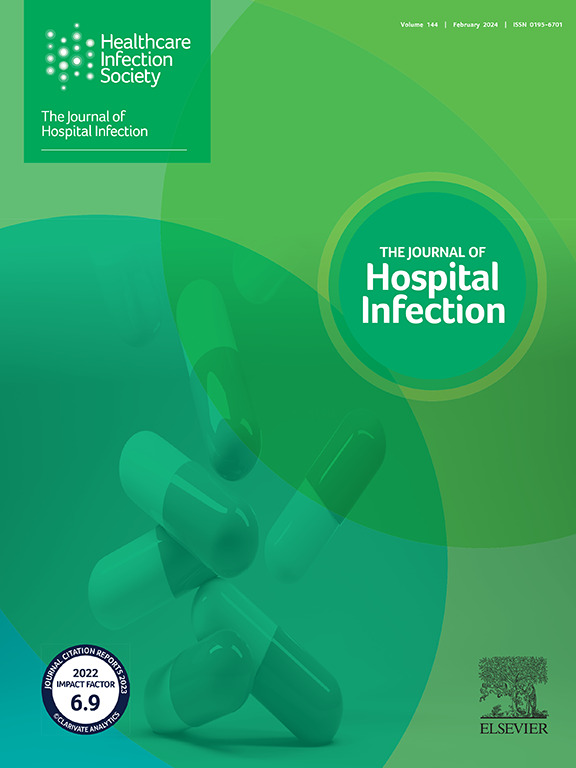Decontamination methods of needleless connectors in central venous access: a randomized controlled trial
IF 3.9
3区 医学
Q1 INFECTIOUS DISEASES
引用次数: 0
Abstract
Background
Needleless connectors (NCs) are essential for central venous access but can cause bloodstream infections if contaminated. Currently, inconsistent guidelines on the optimal disinfectant and duration for NCs hinder nursing practice standardization. Notably, 75% ethanol, which is widely used in China, lacks rigorous comparison with 2% chlorhexidine gluconate (CHG) in ethanol, with existing evidence predominantly from intensive care units rather than outpatient settings.
Aim
To compare the decontamination efficacy of 75% ethanol and 2% CHG in ethanol with scrub durations of 5, 10, and 15 s on NCs in outpatients.
Methods
Using a factorial randomized controlled trial design, 360 NCs from 111 adult cancer patients with central venous access were randomized to six protocols: 75% ethanol or 2% CHG in ethanol, each scrubbed for 5, 10, or 15 s. Baseline and post-decontamination samples were collected for microbial culture to assess decontamination efficacy.
Findings
Baseline contamination occurred in 80.6% of 356 NCs, with brachial vein catheterization increasing risk (odds ratio: 3.12; 95% confidence interval: 1.20–8.12) and prolonged indwelling (>6 months) reducing it (0.25; 0.07–0.88). No significant difference was observed between 75% ethanol and 2% CHG in ethanol (P > 0.05). However, 15 s scrubbing achieved superior efficacy versus 5 s and 10 s protocols (P = 0.024).
Conclusion
This study found 75% ethanol equivalent to 2% CHG in ethanol for disinfection, supporting ≥15 s scrubs but noting residual contamination risks. By contextualizing disinfection protocols for outpatient populations and 75% ethanol-based practices, this study provides actionable evidence to standardize scrub durations and optimize resource allocation in diverse clinical settings.
中心静脉通路中无针接头的去污方法:一项随机对照试验。
背景:无针连接器(NCs)对于中心静脉通路是必不可少的,但如果被污染会导致血液感染。目前,关于NCs的最佳消毒剂和持续时间的不一致指南阻碍了护理实践的标准化。值得注意的是,在中国广泛使用的75%乙醇缺乏与2%葡萄糖酸氯己定(CHG)乙醇的严格比较,现有证据主要来自ICU而不是门诊。本研究旨在比较75%乙醇和2%乙醇中CHG在5、10和15秒擦洗时间下对门诊nc的去污效果。方法:采用因子随机对照试验设计,来自111例中心静脉通道的成年癌症患者的360例nc被随机分为6个方案:75%乙醇或2%乙醇CHG,每个方案洗涤5、10或15秒。收集基线和去污后样本进行微生物培养,以评估去污效果。结果:356例nc中基线污染发生率为80.6%,臂静脉置管增加风险(OR=3.12, 95%CI 1.20 ~ 8.12),延长留置(bbb6个月)降低风险(OR=0.25, 95%CI 0.07 ~ 0.88)。75%乙醇与2%乙醇中CHG含量差异无统计学意义(P < 0.05)。然而,15秒擦洗比5秒和10秒擦洗效果更好(P=0.024)。结论:本研究发现75%乙醇相当于2%乙醇中的CHG用于消毒,支持≥15秒擦洗,但注意残留污染风险。通过对门诊人群的消毒方案和75%乙醇为基础的实践进行背景分析,本研究为标准化擦洗时间和优化不同临床环境中的资源分配提供了可操作的证据。
本文章由计算机程序翻译,如有差异,请以英文原文为准。
求助全文
约1分钟内获得全文
求助全文
来源期刊

Journal of Hospital Infection
医学-传染病学
CiteScore
12.70
自引率
5.80%
发文量
271
审稿时长
19 days
期刊介绍:
The Journal of Hospital Infection is the editorially independent scientific publication of the Healthcare Infection Society. The aim of the Journal is to publish high quality research and information relating to infection prevention and control that is relevant to an international audience.
The Journal welcomes submissions that relate to all aspects of infection prevention and control in healthcare settings. This includes submissions that:
provide new insight into the epidemiology, surveillance, or prevention and control of healthcare-associated infections and antimicrobial resistance in healthcare settings;
provide new insight into cleaning, disinfection and decontamination;
provide new insight into the design of healthcare premises;
describe novel aspects of outbreaks of infection;
throw light on techniques for effective antimicrobial stewardship;
describe novel techniques (laboratory-based or point of care) for the detection of infection or antimicrobial resistance in the healthcare setting, particularly if these can be used to facilitate infection prevention and control;
improve understanding of the motivations of safe healthcare behaviour, or describe techniques for achieving behavioural and cultural change;
improve understanding of the use of IT systems in infection surveillance and prevention and control.
 求助内容:
求助内容: 应助结果提醒方式:
应助结果提醒方式:


